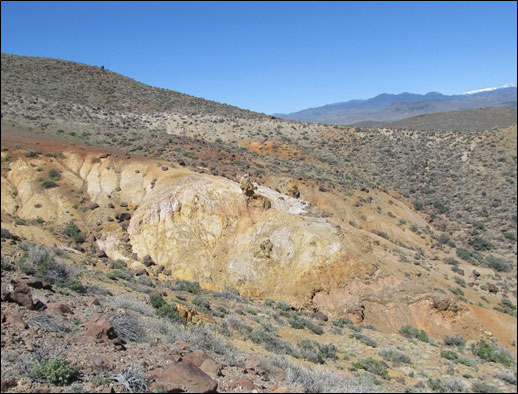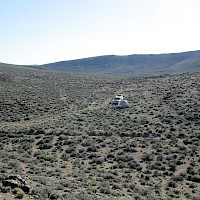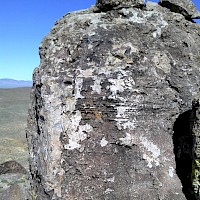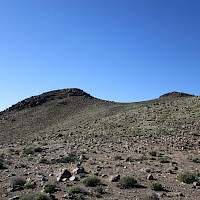The Skylight Property is located in the Republic Mining District on the west side of the Royston Hills in Nye County, Nevada. It covers a nearly completely preserved epithermal system complete with silica caps. It drew no attention from historic prospectors but was recognized as a significant target in more recent years and explored by Rimfire Minerals Corporation and Newmont Mining in the early 2000’s.
The Skylight Property is underlain by mid-Tertiary ash-flow tuffs unconformably overlying Triassic Luning Formation carbonates and clastics. Structure in the area is dominated by NW trending right lateral strike-slip faults and subordinate N to NNE striking steeply dipping secondary normal faults. The Skylight Property is centred on flat lying silica beds capping the volcanic rocks. These form the tops of the local hills, preserving the underlying rocks from erosion. The silica caps are dominantly brecciated but locally show flat-lying thin-bedded silica indicating they were deposited at the very top of a hydrothermal cell in an epithermal outflow zone.
Quartz veins up to about 1 m wide and clay alterations zones tens of metres wide occur at lower elevations in gullies on the flanks of the silica-capped hills. One vein shows prominent quartz-after-calcite (QUAC) texture indicating epithermal boiling while dickite and hydrothermal kaolinite are found in some of the clay alteration zones. The peripheral veining carries low grade gold values with historic surface sampling returning values up to 2.04 g/t Au. Sampling by Silver Range in 2017 returned best results of 0.86 g/t Au and 67.6 g/t Ag from a suite of 24 grab samples.
Rimfire drilled 6 holes (1575 metres) on the flanks of the silica caps at Skylight in 2007. (Rimfire Minerals Corporation News Release – November 6, 2007). Intercepts were reported from three holes: 10.67 m @ 0.49 g/t Au; 3.05 m @ 1.766 g/t Au; and 3.05 m @ 0.608 g/t Au.
In June 2017, Silver Range conducted a three-dimensional induced polarization (3DIP) survey over a grid centred on the silica caps at Skylight. The survey defined a network of chargeability linears, collectively forming a network with a nexus centred beneath the region of the silica caps. Elevated gold, silver and arsenic values are associated with several of these linear chargeability anomalies. The southern terminus of the most prominent appears to be the target inconclusively tested in Rimfire hole RC07-04. This failed to reach target depth but nonetheless intersected 10.67 m @ 0.490 g/t Au. Surface rock samples collected in this area returned 0.53 g/t Au and 0.86 g/t Au. The chargeability linear follows a gully with an associated clay alteration zone containing dickite and hydrothermal kaolinite.
Results of exploration work to date at Skylight indicate that it is underlain by a nearly completely preserved epithermal system and that the system is gold-bearing. The recent geophysical surveys have defined the system’s structural architecture and identified an area where fluid may have been most intense. Silver Range has designed a drill program to conclusively test this system, targeting the linear chargeability anomalies with best geochemical support.






